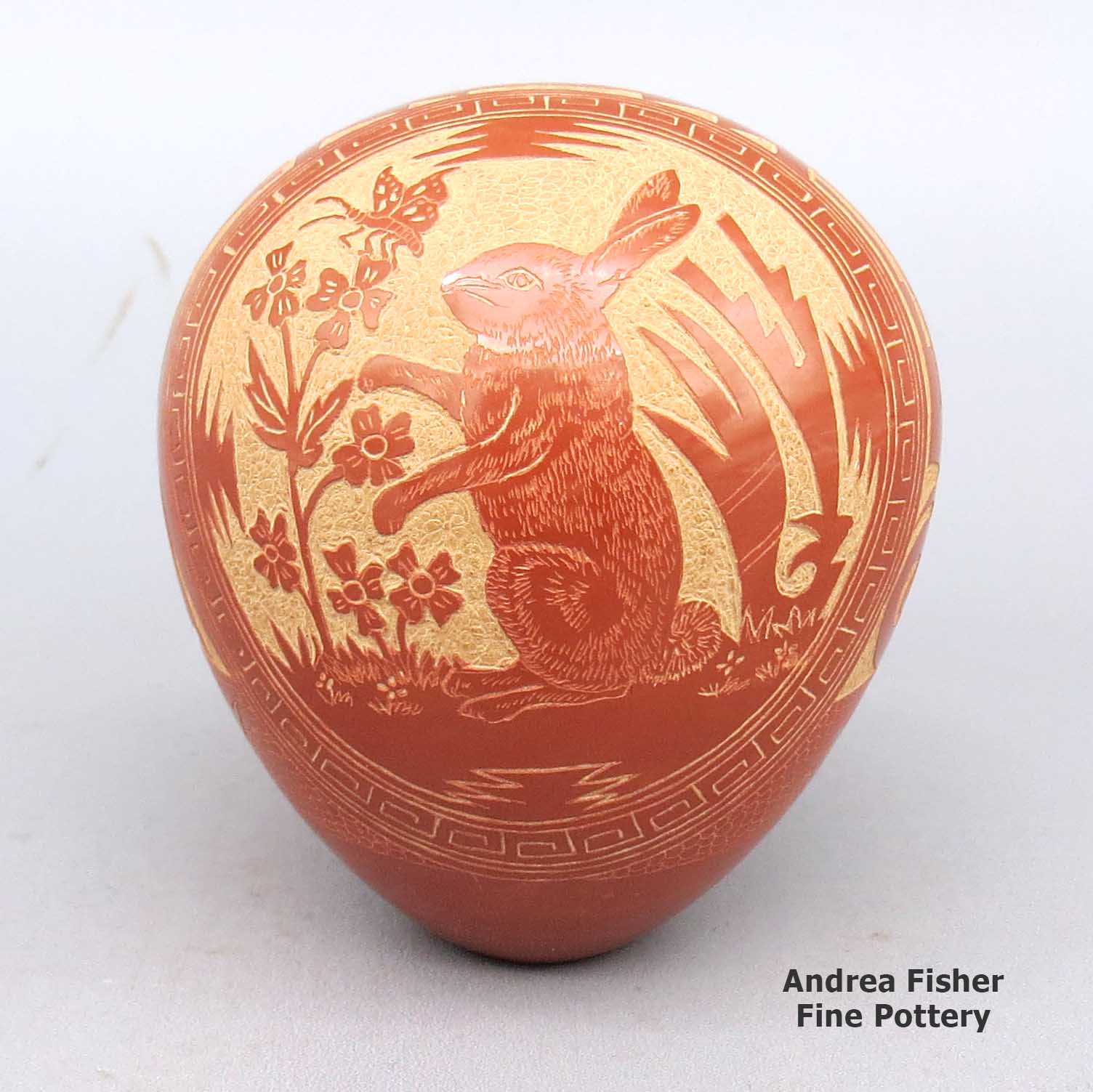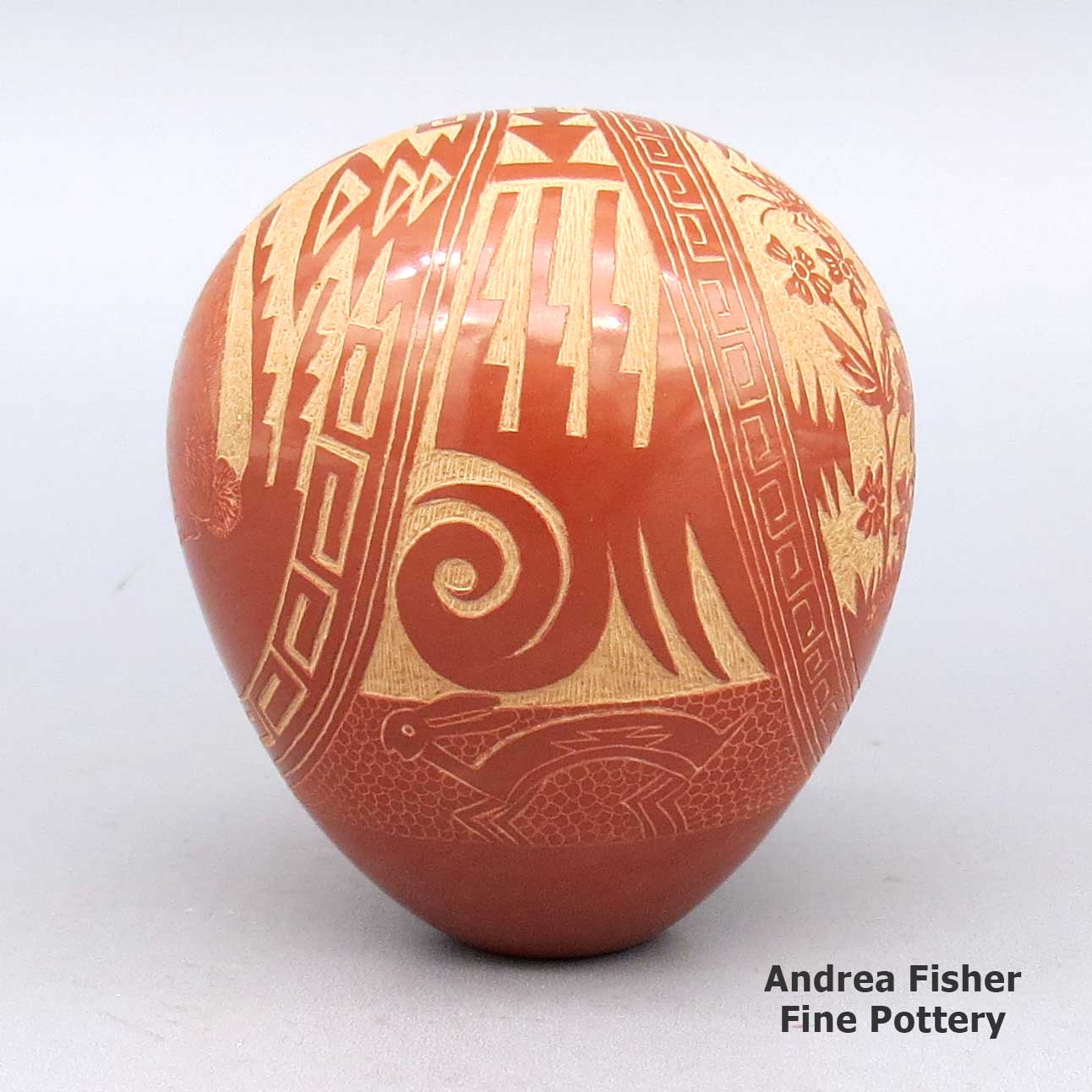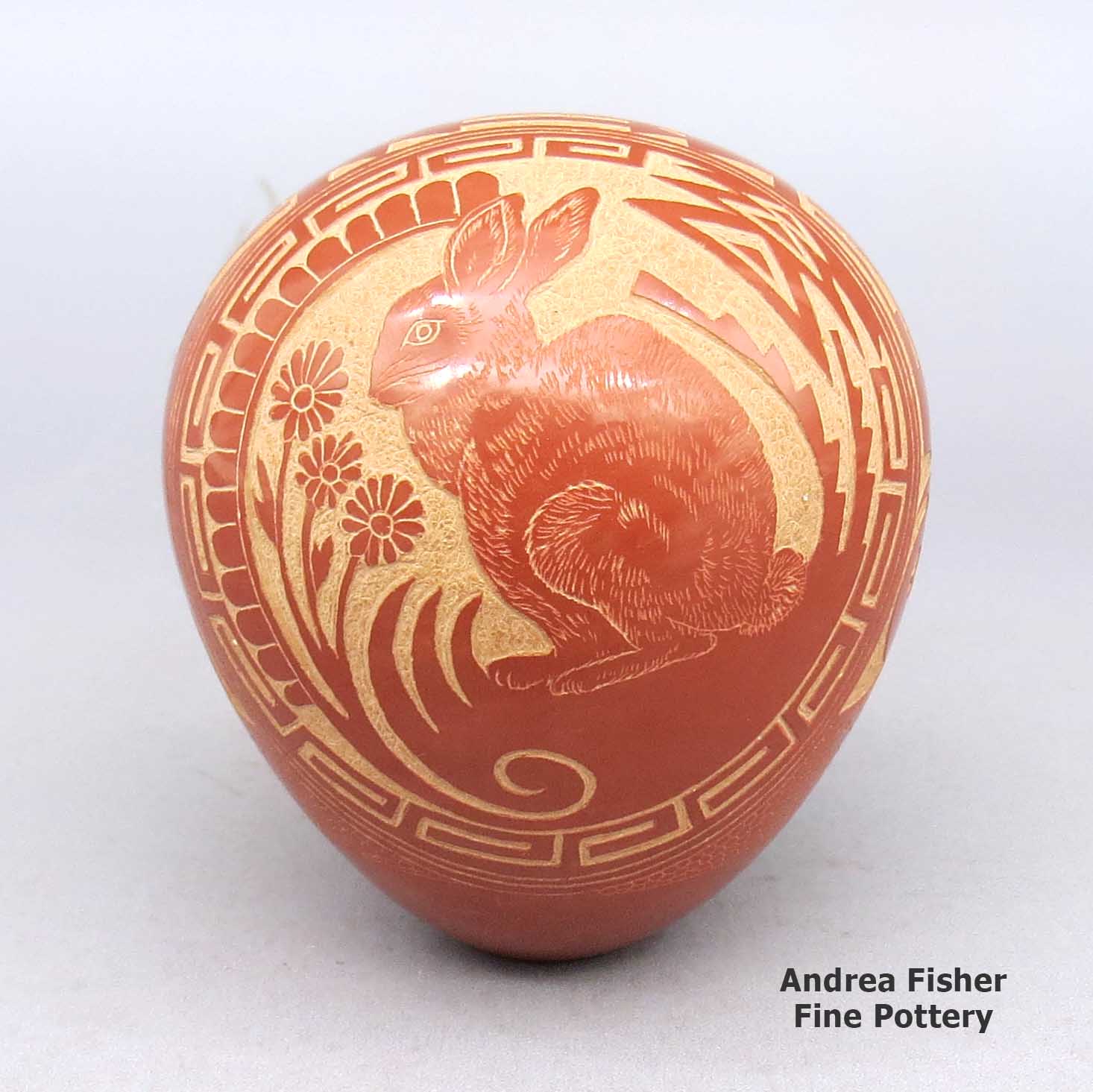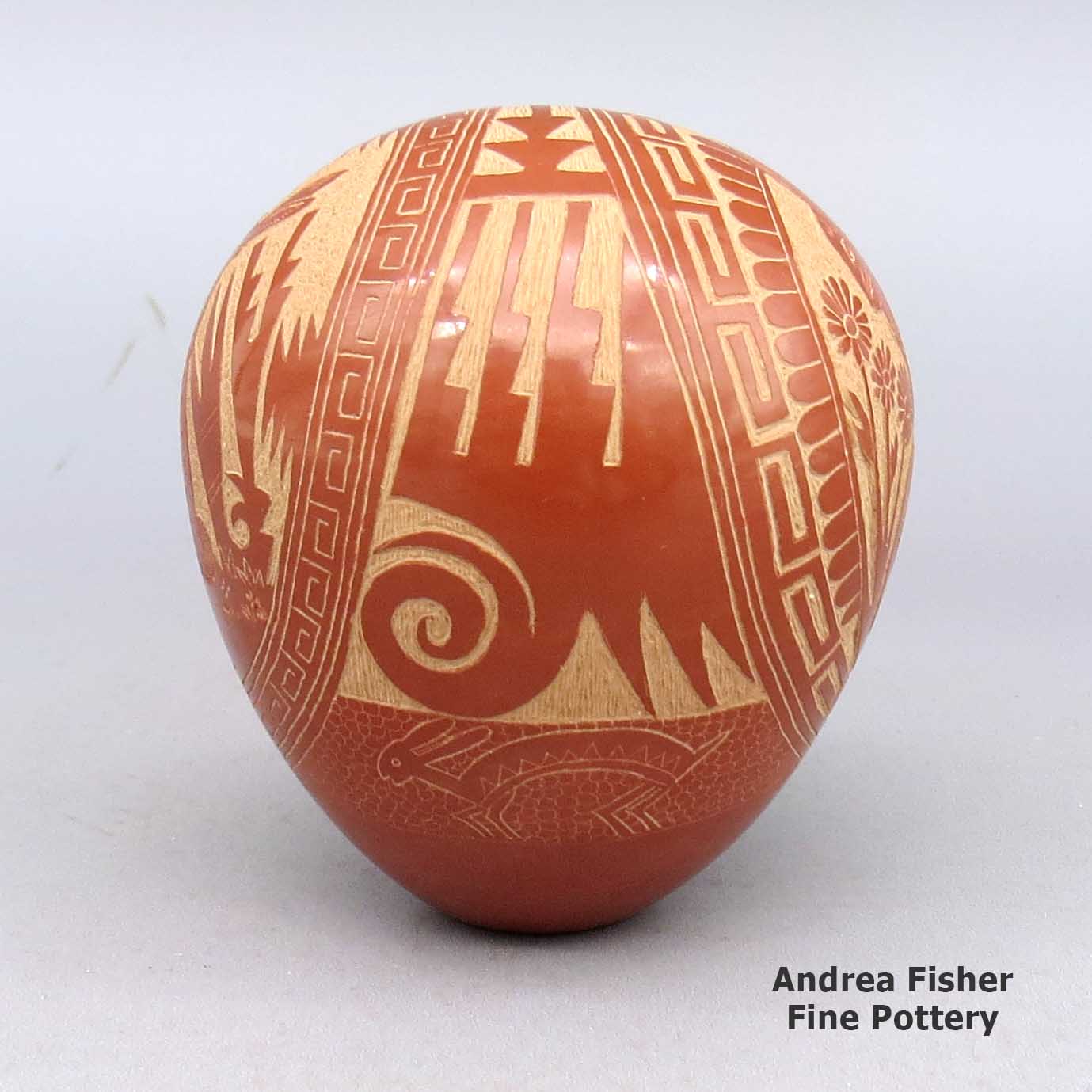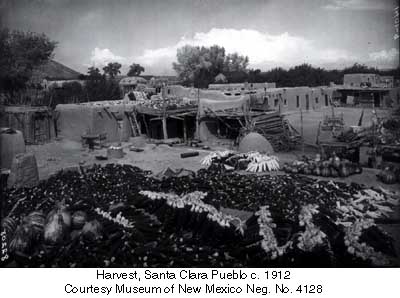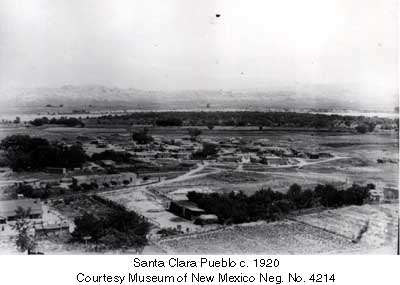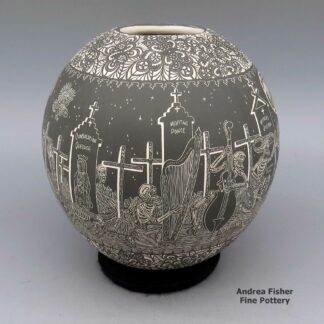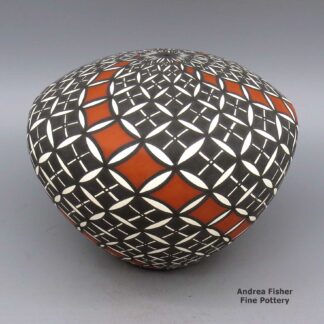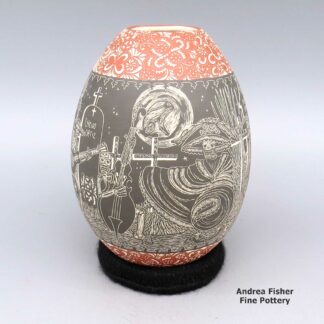| Dimensions | 2.25 × 2.25 × 2.5 in |
|---|---|
| Condition of Piece | Very good |
| Signature | Grace Medicine Flower 85695, with flower hallmark |
Grace Medicine Flower, plsc2k125: Small red seed pot with sgraffito geometric design
$850.00
A small red seed pot decorated with a sgraffito rabbit, flower, butterfly and geometric design
In stock
Brand
Medicine Flower, Grace
After graduating from high school and working as a secretary for a while, Grace decided to begin working with clay. She was producing pottery for the marketplace by the early 1960s. She and her brother, Joseph Lonewolf, began developing the sgraffito technique to etch the surfaces of their pottery in the late 1960s. Grace said it really opened her eyes when she sold her first piece of sgraffito pottery for $11, significantly more than she got for any of her other, more traditional pieces.
For years most of her pottery disappeared into private collections before it got to the greater marketplace. She hasn't produced any pottery in a while.
In 2006 the Southwest Association for Indian Arts awarded Grace their Lifetime Achievement Award.
Some Exhibits Grace's works have been part of
- Gifted! Recent Additions to the Heard Collection. Heard Museum. Phoenix, Arizona. December 18, 2015
- Something Old, Something New, Nothing Borrowed: New Acquisitions from the Heard Museum Collection. Heard Museum, Phoenix, Arizona. April 2, 2011 - March 18, 2012
- New Works in Clay with Artists in Attendance. King Galleries. Scottsdale, Arizona. March 4, 2010
- Crafted to Perfection: the Nancy & Alan Cameros Collection of Southwestern Pottery. Rockwell Museum of Western Art. Corning, New York. November 23, 2007 - May 18, 2008
- Choices and Change: American Indian Artists in the Southwest. Heard Museum North. Scottsdale, Arizona. June 30, 2007
- Innovators in Contemporary Native Clay: Grace Medicine Flower, Polychrome Perfection. King Galleries of Scottsdale. Scottsdale, Arizona. Marcy 1 - 3, 2007
- Home: Native Peoples in the Southwest. Heard Museum. Phoenix, Arizona. Opened May 22, 2005
- Breaking the Surface: Carved Pottery Techniques and Designs. Heard Museum. Phoenix, Arizona. October 2, 2004 - October 2005
- The Collecting Passions of Dennis and Janis Lyon. Heard Museum. Phoenix, Arizona. May 1 - September 2004
- Every Picture Tells A Story. Heard Museum. Phoenix, Arizona. September 20, 2002
- Hold Everything! Masterworks of Basketry and Pottery from the Heard Museum. November 10, 2001 - March 10, 2002
- Images, Artists, Styles: Recent Acquisitions from the Heard Museum Collection. Heard Museum North. Scottsdale, Arizona. July 2001 - December 2002
- Lovena Ohl: An Eye for Art, A Heart for Artists. Heard Museum. Phoenix, Arizona. January 15, 2000 - August 15, 2000</li.
- Scottsdale Indian Artists of America Show: James Little, Grace Medicine Flower. Lovena Ohl Gallery. Scottsdale, Arizona. January 19 - 21, 1999
- The Legacy of Generations: Pottery by American Indian Women. Heard Museum. Phoenix. Arizona. February 14 - May 17, 1998
- New Works in Clay: Joseph Lonewolf, Grace Medicine Flower. King Galleries of Scottsdale. Scottsdale, Arizona. February 12, 1998
- The Legacy of Generations: Pottery by American Indian Women. The Museum of Women and the Arts. Washington, District of Columbia. October 9, 1997 - January 11, 1998
- Recent Acquisitions from the Herman and Claire Bloom Collection. Heard Museum. Phoenix, Arizona. January 11, 1997 - July 1997
- Grace Medicine Flower, Lu Ann Tafoya: An Exhibition of New Works. Gallery 10. Scottsdale, Arizona. February 15, 1996 Rain. Heard Museum. Phoenix, Arizona. June 19, 1993 - July 1995
- Fifth Annual Hollywood Premiere. Four Seasons Hotel, Los Angeles, California. Gallery 10. November 23-24, 1991 1990-1991 Season Showings of American Indian Art. Lovena Ohl Gallery. Scottsdale, Arizona. February 8, 1991
- Magic in Clay: Artistic Miniatures of the American Southwest. University of Nebraska State Museum. Lincoln, Nebraska. 1991
- Fourth Annual Hollywood Premiere. Four Seasons Hotel, Los Angeles, CA. Gallery 10. November 17-18, 1990
- Indian Market Week Shows: Grace Medicine Flower, Richard Zane Smith, Dorothy Torivio. Gallery 10. Santa Fe, New Mexico. August 10 - 17, 1990
- Special Evening. Lovena Ohl Gallery. Scottsdale, Arizona. July 5, 1990
- New Works from Santa Clara and San Ildefonso. Gallery 10. Scottsdale, Arizona. March 1, 1990
- Grace Medicine Flower, Charles Supplee, Dennis. Lovena Ohl Gallery. Scottsdale, Arizona. January 20, 1989
- American Indian Art: the Collecting Experience. Elvehjem Museum of Art. Madison, Wisconsin. May 7, 1988 - July 3, 1988
- Individual Statements of Style. Gallery 10. Scottsdale, Arizona. February 25, 1988
- 1986 -1987 Season Showings of American Indian Art. Lovena Ohl Gallery. Scottsdale, Arizona. April 10, 1987
- The Santa Fe Indian Market Expanding Exhibit. Morning Star Gallery and Gallery 10. Santa Fe, New Mexico. July 26 - August 31, 1985
- Reception Honoring Harvey Begay and Grace Medicine Flower. Lovena Ohl Gallery. Scottsdale, Arizona. February 22, 1985
- Indian Market East: Grace Medicine Flower, Jody Folwell, Nancy Youngblood Cutler, Nathan Youngblood. Gallery 10. New York City, New York. April 12 - 28, 1984
- Reception Honoring Grace Medicine Flower and Larry Golsh. Lovena Ohl Gallery. Scottsdale, Arizona. December 16, 1983
- The Ceramics of Grace Medicine Flower & Jody Folwell. Gallery 10. Scottsdale, Arizona. February 24 - March 9, 1983
- Contemporary Pottery: Grace Medicine Flower. Gallery 10. Scottsdale, Arizona. February 20 -March 13, 1981
- American Indian Art in the 1980s. The Native American Center for the Living Arts. Niagara Falls, New York. 1981
- One Space, Three Visions. Albuquerque Museum. Albuquerque, New Mexico. 1979
- Show and Sale of Pottery by Joseph Lonewolf and Grace Medicine Flower. Old Territorial Shop. Scottsdale, Arizona. November 26, 1977
- Joseph Lonewolf, Grace Medicine Flower. Adobe Galleries. Las Vegas, Nevada. March 24-26, 1977
- The Joseph Lonewolf Family Show. Tanner's Indian Arts. Scottsdale, Arizona. November 20 - 23, 1975
- Grace Medicine Flower. Ashton Gallery. Scottsdale, Arizona. March 16, 1975
- Tony Begay Memorial Show. Heard Museum. Phoenix, Arizona. February 2-17, 1974. Note: exhibition and auction to benefit the children of Tony Begay; includes artwork by Tony Begay and many of his Indian artist friends
- Private Showing of Pottery: Grace Medicine Flower. Tanner's Indian Arts. Scottsdale, Arizona. March 30-31, 1972
A Short History of Santa Clara Pueblo

Santa Clara Pueblo straddles the Rio Grande about 25 miles north of Santa Fe. Of all the pueblos, Santa Clara has the largest number of potters.
The ancestral roots of the Santa Clara people have been traced to ancient pueblos in the Mesa Verde region in southwestern Colorado. When the weather in that area began to get dry between about 1100 and 1300 CE, some of the people migrated to the Chama River Valley and constructed Poshuouinge (about 3 miles south of what is now Abiquiu on the edge of the mesa above the Chama River). Eventually reaching two and three stories high with up to 700 rooms on the ground floor, Poshuouinge was inhabited from about 1375 CE to about 1475 CE.
Drought then again forced the people to move. One group of the people went to the area of Puyé (along Santa Clara Canyon, cut into the eastern slopes of the Pajarito Plateau of the Jemez Mountains). Another group went south of there to what we now call Tsankawi. A third group went a bit to the north, following the Rio Chama down to where it met the Rio Grande and founded Ohkay Owingeh on the northwest side of that confluence.
Beginning around 1580, another drought forced the residents of the Puyé area to relocate closer to the Rio Grande. There, near the point where Santa Clara Creek merged into the Rio Grande, they founded what we now know as Santa Clara Pueblo. Ohkay Owingeh was to the north on the other side of the Rio Chama. That same dry spell forced the people down the hill from Tsankawi to the Rio Grande where they founded San Ildefonso Pueblo to the south of Santa Clara, on the other side of Black Mesa.
In 1598 Spanish colonists from nearby Yunqué (the seat of Spanish government near the renamed "San Juan de los Caballeros" Pueblo) brought the first missionaries to Santa Clara. That led to the first mission church being built around 1622. However, the Santa Clarans chafed under the weight of Spanish rule like the other pueblos did and were in the forefront of the Pueblo Revolt of 1680. One pueblo resident, a mixed black and Tewa man named Domingo Naranjo, was one of the rebellion's ringleaders.
When Don Diego de Vargas came back to the area in 1694, he found most of the Santa Clarans were set up on top of nearby Black Mesa (with the people of San Ildefonso, Pojoaque, Tesuque and Nambé). An extended siege didn't subdue them but eventually, the two sides negotiated a treaty and the people returned to their pueblos. However, successive invasions and occupations by northern Europeans took their toll on the pueblos over the next 250 years. The Spanish flu pandemic in 1918 almost wiped them out.
Today, Santa Clara Pueblo is home to as many as 2,600 people and they comprise probably the largest per capita number of artists of any North American tribe (estimates of the number of potters run as high as 1-in-4 residents).
For more info:Pueblos of the Rio Grande, Daniel Gibson, ISBN-13:978-1-887896-26-9, Rio Nuevo Publishers, 2001
Upper photo courtesy of Einar Kvaran, Creative Commons Attribution-Share Alike 3.0 Unported License
About the Seed Pot
It was a matter of survival to the ancient Native American people that seeds be stored properly until the next planting season. Small, hollow pots were made to ensure that the precious seeds would be kept safe from moisture, light, bugs, reptiles and rodents.
After seeds were put into the pot, the small hole in the pot was plugged. The following spring the plug was removed and the seeds were shaken from the pot directly onto the planting area.
Today, seed pots are no longer necessary due to readily available seeds from commercial suppliers. However, seed pots continue to be made as beautiful, decorative works of art.
The sizes and shapes of seed pots have evolved and vary greatly, depending on the vision of Clay Mother as developed through the artist. The decorations vary, too, from undecorated white, buff or red seed pots to multi-colored painted, carved, applique and sgraffito designs, sometimes with inlaid gemstones, micaceous clay and silver or clay lids.
Because of the multitude of shapes and sizes, the name "seed pot" is generally reserved for pieces with tiny openings.
About Sgraffito Designs
"Sgraffito" is from the Italian, meaning "to scratch." It's a technique wherein designs are scratched into the surface of a piece of pottery, generally with the use of a needle, dental tool or other sharp object. Also usually, the surface of the piece has been slipped with one color of clay and scratching through it reveals the design in a different color of clay. Some potters will slip a piece with layers of various colors of clay and the depth of their etching gives a color depth to their designs. Some will fire their pieces first, using the firing process to produce different effects in the clay. When they etch them after, the different depths they etch to also lend a color depth to their designs.
The sgraffito technique has been widely used in Europe for centuries but only came to the pueblos in the late 1960s. Even then, it's only really been developed at Jemez, Santa Clara, San Ildefonso and Ohkay Owingeh. At Santa Clara, Joseph Lonewolf and his father, Camilio Tafoya, and sister, Grace Medicine Flower, have been credited as being among the first to develop sgraffito. Corn Moquino was there, too, in those early days. At San Ildefonso, Juan Tafoya and Barbara Gonzales were among the first. At Ohkay Owingeh, Alvin Curran and Tom Tapia were among the first. Juanita Fragua was among the earliest at Jemez.
In Mata Ortiz, virtually anything goes and sgraffito has been widely used since the early 1970s. Again, some potters scratch their designs before firing, some after. Some scratch to add textured designs to an otherwise same-colored surface. Some carve and scratch and then fire. Some carve, paint and fire, then scratch... The tools they use vary from dental picks and exacto knives to nails, file handles and sharpened bicycle spokes.
Camilio Tafoya Family Tree - Santa Clara Pueblo
Disclaimer: This "family tree" is a best effort on our part to determine who the potters are in this family and arrange them in a generational order. The general information available is questionable so we have tried to show each of these diagrams to living members of each family to get their input and approval, too. This diagram is subject to change should we get better info.
- Camilio Tafoya (1902-1995) & Agapita Silva (1904-1959)
- Lucy Year Flower (1935-2012) & Joe Tafoya
- Kelli Little Kachina (1967-2014)
- Myra Little Snow (1962-)
- Forrest Red Cloud Tafoya
- Shawn Tafoya (1968-)
- Joseph Lonewolf (1932-2014) & Katheryn Lonewolf
- Greg Lonewolf (1952-)
- Rosemary Apple Blossom Lonewolf (1954-) & Paul Speckled Rock (1952-2017)
- Adam Speckled Rock
- Susan Romero & Mike Romero
- Grace Medicine Flower (1938-)
